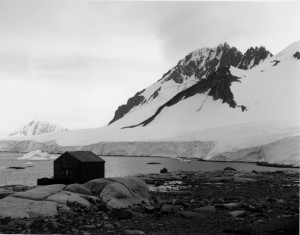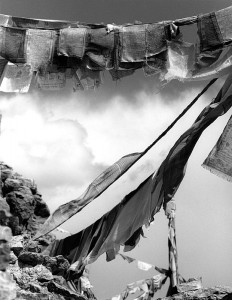I was told that there are four stages in life; you are born, you grow into adulthood, you marry and have children and finally, you give up earthly possessions and seek God. I have completed the first three. I am now an artist and pilgrim. In 2008 I traveled to India and completed the Hindu pilgrimage Char Dham.
In 2010 I made the overland journey into Tibet where I completed the Buddhist kora around the sacred mountain Kailash. And in 2012 I walked the 500 miles of the Catholic Camino de Santiago in northern Spain. It is the immersion and interaction with other pilgrims that has defined my search.
Tibet: As the trail rolled over another rocky bulge of earth I looked ahead at a pilgrim stretched out on the dirt. His arms reached out in front of his body where he would mark the ground, stand and walk to his hand prints, where he would lay down once again. He was demonstrating devotion to his Buddhist faith, something fewer and fewer are now choosing to do according to Geljen. As I stepped to the left to pass, the tired and grimy figure looked up at me and motioned for water. I dropped my pack and pulled out my water bottle. As he stood up and opened his mouth I unscrewed the lid and gave him a drink.
He swallowed and nodded for more and I filled his mouth with water for a second and then a third time. Finished he looked into my eyes, bowed his head and returned to his prostrations. I gathered my pack and as I walked away it began to lightly snow even though the sun was still shining. The clouds parted and Mt. Kailash appeared. Snowflakes mixed with emotion as I walked on in solitude.
India: The loose dirt gave way under my feet, spilling rocks down the slope as I made my  way to the river. I reached the sandy bank and stepped onto a flat rock where I could kneel down to touch the cold glacial water. A hundred yards upstream it rushed out of the bottom of the ice wall. This was the “Mouth of the Cow,” Gaumukh, the source and headwater of the sacred river Ganges, beginning its long journey towards the plains of India. I cupped my hands in the frigid water and lifted them up and over my head, letting the drops fall, wetting my hair. As I walked back along the trail I passed an elderly man on his own pilgrimage who smiled and said what a happy day this was. I grinned and agreed that yes, this was a happy day. He looked intensely straight into my eyes and hugged me and repeated, ” Yes, this is a very happy day.”
way to the river. I reached the sandy bank and stepped onto a flat rock where I could kneel down to touch the cold glacial water. A hundred yards upstream it rushed out of the bottom of the ice wall. This was the “Mouth of the Cow,” Gaumukh, the source and headwater of the sacred river Ganges, beginning its long journey towards the plains of India. I cupped my hands in the frigid water and lifted them up and over my head, letting the drops fall, wetting my hair. As I walked back along the trail I passed an elderly man on his own pilgrimage who smiled and said what a happy day this was. I grinned and agreed that yes, this was a happy day. He looked intensely straight into my eyes and hugged me and repeated, ” Yes, this is a very happy day.”
India: As I passed the men who were bent over hand shoveling the embankment one stood up and calmly asked “What is the name of your God?” I responded “God.” He smiled and laughed. As did I.
Spain: “This 34 day walk has been a mental and physical purge. I have become emotional and cried so many times: in the small hamlet churches, at La Cruz de Ferro, over thoughts and memories of those who passed beyond this life and in front of the cathedral in Santiago at the end of the walking; tired, cold and finished as I leaned against my walking staff. Sitting towards the back of the cathedral, I waited for the Pilgrim Mass to begin. A fellow pilgrim who I had seen many times over the last month walked over and shook my hand and told me his name. We are both tired and overwhelmed. A young woman knelt next to me and sobbed. I feel I have come closer to my personal God.”
India: The hike to Vasundhara falls was only another five miles but after the long trek earlier that morning I was moving slowly and tired. Arriving, I dropped my pack and sat in the dirt exhausted. Over my shoulder and up the hill a voice pulled my attention from the valley. Sitting above me on some rocks was a shaggy haired man wrapped in a blanket motioning me to come up and join him. I grabbed my bag and joined him in front of his stone shelter and took the hot flower tea that was prepared by his attendant. I smiled and nodded; him also. He pointed at the flowers, the tea’s ingredient. I sipped the brew, sitting on the stone bench next to him and marveled at the towering peaks and valley that snaked into the mountains. I asked the name of one peak and he laughed as I poorly repeated his words, enjoying my poor pronunciation. Soon, five men hiking up the trail joined us. Taking off their shoes they knelt down and pressed their heads on the feet of my new friend, a holy man, a sadhu. They then bowed to me, one might say reverence by association.
